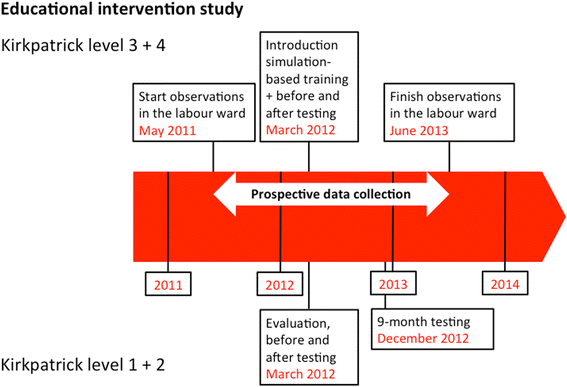Clinical performance and patient outcome after simulation-based training in prevention and management of postpartum haemorrhage: an educational intervention study in a low-resource setting
- PMID: 28893211
- PMCID: PMC5594489
- DOI: 10.1186/s12884-017-1481-7
Clinical performance and patient outcome after simulation-based training in prevention and management of postpartum haemorrhage: an educational intervention study in a low-resource setting
Abstract
Background: Postpartum haemorrhage (PPH) is a major cause of maternal mortality. Prevention and adequate treatment are therefore important. However, most births in low-resource settings are not attended by skilled providers, and knowledge and skills of healthcare workers that are available are low. Simulation-based training effectively improves knowledge and simulated skills, but the effectiveness of training on clinical behaviour and patient outcome is not yet fully understood. The aim of this study was to assess the effect of obstetric simulation-based training on the incidence of PPH and clinical performance of basic delivery skills and management of PPH.
Methods: A prospective educational intervention study was performed in a rural referral hospital in Tanzania. Sixteen research assistants observed all births with a gestational age of more than 28 weeks from May 2011 to June 2013. In March 2012 a half-day obstetric simulation-based training in management of PPH was introduced. Observations before and after training were compared. The main outcome measures were incidence of PPH (500-1000 ml and >1000 ml), use and timing of administration of uterotonic drugs, removal of placenta by controlled cord traction, uterine massage, examination of the placenta, management of PPH (>500 ml), and maternal and neonatal mortality at 24 h.
Results: Three thousand six hundred twenty two births before and 5824 births after intervention were included. The incidence of PPH (500-1000 ml) significantly reduced from 2.1% to 1.3% after training (effect size Cohen's d = 0.07). The proportion of women that received oxytocin (87.8%), removal of placenta by controlled cord traction (96.5%), and uterine massage after birth (93.0%) significantly increased after training (to 91.7%, 98.8%, 99.0% respectively). The proportion of women who received oxytocin as part of management of PPH increased significantly (before training 43.0%, after training 61.2%). Other skills in management of PPH improved (uterine massage, examination of birth canal, bimanual uterine compression), but these were not statistically significant.
Conclusions: The introduction of obstetric simulation-based training was associated with a 38% reduction in incidence of PPH and improved clinical performance of basic delivery skills and management of PPH.
Keywords: Education; Low-resource settings; Obstetrics; Postpartum haemorrhage; Simulation-based training.
Conflict of interest statement
Ethics approval and consent to participate
Ethical approval was obtained from the Tanzanian National Institute for Medical Research (reference NIMR/HQ/R.8a/Vol.IX/1247), the Tanzania Commission for Science and Technology (reference 2013–41-ER-2011-201), and from the VU University Medical Centre, the Netherlands (reference 2011/389). Permission to conduct the study was obtained from the hospital management. Individual consent from observed individuals was not obtained because there were no interventions at individual level. Data was collected without possible identification of the patient and without interfering with treatment or patient outcome.
Consent for publication
Not applicable.
Competing interests
Dr. Nelissen received an unconditional stipend from the Laerdal Foundation for Acute Medicine, Stavanger, Norway. Dr. Ersdal holds a post-doctoral position at the Stavanger University Hospital, which is financed by an unrestricted grant from the Laerdal Foundation for Acute Medicine. All other authors do not have any competing interests.
Publisher’s Note
Springer Nature remains neutral with regard to jurisdictional claims in published maps and institutional affiliations.
Figures
Similar articles
-
Helping Mothers Survive Bleeding After Birth: retention of knowledge, skills, and confidence nine months after obstetric simulation-based training.BMC Pregnancy Childbirth. 2015 Aug 25;15:190. doi: 10.1186/s12884-015-0612-2. BMC Pregnancy Childbirth. 2015. PMID: 26303614 Free PMC article.
-
Helping mothers survive bleeding after birth: an evaluation of simulation-based training in a low-resource setting.Acta Obstet Gynecol Scand. 2014 Mar;93(3):287-95. doi: 10.1111/aogs.12321. Epub 2014 Jan 15. Acta Obstet Gynecol Scand. 2014. PMID: 24344822
-
Postpartum hemorrhage: guidelines for clinical practice from the French College of Gynaecologists and Obstetricians (CNGOF): in collaboration with the French Society of Anesthesiology and Intensive Care (SFAR).Eur J Obstet Gynecol Reprod Biol. 2016 Mar;198:12-21. doi: 10.1016/j.ejogrb.2015.12.012. Epub 2015 Dec 21. Eur J Obstet Gynecol Reprod Biol. 2016. PMID: 26773243
-
Active management of the third stage of labour: prevention and treatment of postpartum hemorrhage.J Obstet Gynaecol Can. 2009 Oct;31(10):980-993. doi: 10.1016/S1701-2163(16)34329-8. J Obstet Gynaecol Can. 2009. PMID: 19941729 Review.
-
[Active management of the third stage of labour (AMTSL) - the end of a 50 years-dogma?].Z Geburtshilfe Neonatol. 2013 Oct;217(5):173-6. doi: 10.1055/s-0033-1351277. Epub 2013 Oct 29. Z Geburtshilfe Neonatol. 2013. PMID: 24170442 Review. German.
Cited by
-
Assessing the Effect of E-Learning on Perineal Repair Knowledge and Skill Acquisition.PRiMER. 2022 Jun 8;6:11. doi: 10.22454/PRiMER.2022.425794. eCollection 2022. PRiMER. 2022. PMID: 35801196 Free PMC article. No abstract available.
-
Evaluating the Instructional Design and Effect on Knowledge, Teamwork, and Skills of Technology-Enhanced Simulation-Based Training in Obstetrics in Uganda: Stepped-Wedge Cluster Randomized Trial.JMIR Med Educ. 2021 Feb 5;7(1):e17277. doi: 10.2196/17277. JMIR Med Educ. 2021. PMID: 33544086 Free PMC article.
-
Simulation-Based Education as a Solution to Challenges Encountered with Clinical Teaching in Nursing and Midwifery Education in Malawi: A Qualitative Study.J Nurs Manag. 2024 Jun 24;2024:1776533. doi: 10.1155/2024/1776533. eCollection 2024. J Nurs Manag. 2024. PMID: 40224831 Free PMC article.
-
A scoping review on the contribution of interprofessional collaborative practices on preventing and managing post-partum haemorrhage in the health care system.BMC Nurs. 2025 Apr 24;24(1):455. doi: 10.1186/s12912-025-02988-z. BMC Nurs. 2025. PMID: 40275279 Free PMC article.
-
Global consensus statement on simulation-based practice in healthcare.Adv Simul (Lond). 2024 May 21;9(1):19. doi: 10.1186/s41077-024-00288-1. Adv Simul (Lond). 2024. PMID: 38769577 Free PMC article.
References
MeSH terms
Substances
LinkOut - more resources
Full Text Sources
Other Literature Sources



